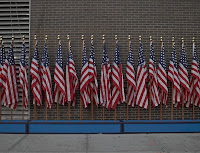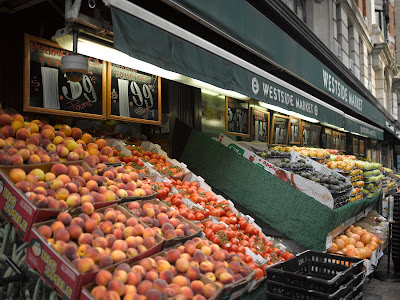As we stroll through more and more neighbourhoods and extend further our reach into the city's life and habits, we discover new startling and striking features and facts (see also Basilio's post on the strange regime of food pricing). One of our new observations pertains to the use of language in public space.
The aptitude of the English language for marketing slogans and other advertisements is a commonplace. So much so that most of us have internalized and adopted many slogans and phrases. On the one hand, this phenomenon is certainly due to the predominance of the English language in global communication; on the other hand, however, English seems to be particularly well suited to bringing a message to the point in a straightforward, smooth and spirited way. What is more, these slogans are (usually) intelligible to all.
Living in New York has revealed to us that this particular use of the English language doesn't stop at the limits of the advertisement world, but has shaped various different instances of communication in public space.
1 and 2 trains usually run on two parallel tracks. However, as it happens, 2 trains "go local" (i.e., stop skipping intermediary subway stations) at some point in the evening and therefore change to the 1 train track. A well visible panel informs travellers about this peculiarity, specifying that "late nights 2 train also stops here". Being Swiss as we are, we obviously wonder about the inaccuracy of a time indication such as "late nights", yet we are also struck by the universal tangibility of this plain and simple statement. Surely everyone will have understood.
The Metropolitan Transportation Authority (short: MTA) has come up with various other beautiful examples of the use(fulness) of plain language. In contrast to its English counterpart, who prompts us to "mind the gap" in subway stations, the MTA announces upon the arrival of any train that passengers should "please stand clear from the platform edge". While the London tourist is still asking herself what the gap could be she should remind herself of, her New Yorkian counterpart has by now taken a step back ("don't become a statistics", as the MTA tells us).
MTA, which as a public corporation is an organ of the official New York, regularly informs passengers about enhancements of the New Yorkian network of public transportation, for instance by way of panels placed inside subway coaches. Travelling back home from Columbia I thus learned that MTA has installed several hundreds of new surveillance cameras to improve passenger safety. "Smile."
Yet MTA is not the only organ capable of simplifying communication between authorities and their targets (and thereby extending to a large degree the reach of its messages). Garbage cans in public space usually try to attract people by way of a huge yellow inscription stating simply and plainly "Litter stops here".
Let me finish with another beautiful line from MTA. Waiting for a bus on 79th street today, we saw that two buses in a row were approaching our station, the first obviously not showing any intention of halting at our station. Looking for an explanation or an out-of-order indication, our eyes focused on the destination board at the upper front of the bus. There we read: "Next Bus Please".















































